While winter still bites, I had intended this piece to be about the practicalities of drawing in the landscape on cold days, about what kit to carry and the best tools to withstand chilly weather. But while writing it, I began to think about what it is about drawing, especially drawing outside, that matters so much to me, so while I will come to sharing the useful stuff a little further on, I thought I might also share how I came to value sketching outdoors.
My strongest childhood memory is the sense of contentment I felt while drawing. As an only child I was always very happy with a pencil in my hand and I remember, at about eight years old, my bursting excitement at purchasing a set of Chinese watercolour tubes in my local newsagent, with saved pocket money. I felt I was now a real artist. My first chosen subject was a very dark, red rose, picked from the garden. I was so proud of this painting. So proud, in fact, I took it into school to show my teacher.
“Are you sure you painted this?”
“Well, yes!” I replied indigantly, but I was secretly rather pleased that he thought I had had help. But like so many children, I was steered away from “childish things” and encouraged to pursue proper, academic subjects, and my love of drawing slipped away.
I took up painting again in my twenties with renewed passion and determination, but life intervened and I moved into teaching English, intending to paint in my spare time. But, as anyone who teaches knows, that spare time didn’t manifest and another twenty years slipped by.
Then suddenly I was in my fifties, and a health scare made me look sharply at what I was doing. I realised that life was too precious not to do the thing that made me feel most alive and so I handed in my notice, with little safety net, and decided that I would begin again, before it was too late.
Drawing again, this time out in the countryside, brought back this memory of the dark, red rose. What matters most to me about this pursuit is not the finished drawing, or the attempt to recreate what I see, but how I feel when looking at it. It is easy to sometimes get caught up in detail, but what I strive for is to give a sense of that place, at that time and to keep trying until that elusive moment comes.
I have become quite single minded in carving out time to go out with my sketchbook. I often feel guilty at doing something that brings me so much pleasure, but I push myself outdoors nonetheless. It sometimes takes a while for the mind to settle, and to filter out all of life’s irritants, but by striding out along the lanes, or across the heath, even on a very cold day, walking soon blows away the mental debris and within minutes my attention will shift to what is happening around me: the song of a robin perched high in the branches or a sudden ray of sunlight breaking through the clouds. Worries just seem to evaporate.
I try to perch myself somewhere I am protected from the wind and chills, often against a hedge and off the main walking tracks, so that I can settle down and focus on what I want to draw. How often in life do we just sit in silence like this? I treasure this time alone, away from all distractions. The peace, stillness and absorption in drawing allows you to become more intune with your surroundings. You are not under any pressure, you do not need to show anyone what you have done, you need just to look, explore and try to capture something of what you see. And with each sketch you will have learned something about your choice of material and noticed something that you would not otherwise have seen. You will also have built a bank of memories - every sketch will cement the experience into your consciousness.
And as you sit, you will melt into your environment and you will have encounters with wildlife, not possible in other circumstances. Last year I had a muntjac deer snuffle next to me in the hedgerow, just a few feet away and it pottered about the clearing in which I sat for several minutes, completely unconcerned by my presence, only looking at me occasionally in curiosity. I have had bumbles bees land of my finger as I have painted poppies, a fox almost brush pass me, as I was so still, and often insects wend their way across the page as I draw.
But sometimes it is people who are curious. I used to feel very wary when people walked by, fearing that they would pass comment on what I was doing. But everyone has been invariably kind and polite and are often just curious and interested in what I am doing. It is usually the dogs that spot me first and come sniffing over to investigate. I had a beautiful hound attempt to curl up in my lap this week, much to the mortification of his owner! I am now a familiar sight on the Ling, but one poor lady glimpsed me in a hollow, fearing that I might be hurt called out in concern, and was much relieved when she saw me drawing. She now waves and shouts hello, as she goes by, just to check all is well and I am touched and reassured by her presence. Another young chap asked if he could look at my sketchbook and said, “I have always wanted to draw, but I was put off at school.” After our chat he said he would try again and I do hope he does. Life is too short.
Last night I fell upon this. It is from Mary Oliver’s collection of essays “Upstream”, which I love, but these words struck me:
The most regretful people on earth are those who felt the call to creative work, who felt their own creative power restive and uprising, and gave to it neither power nor time.
Whatever your choice of creative pursuit, go to it, it is later than you think.
My winter drawing kit
With warmer, brighter days on the horizon, it is the perfect time to venture out with a sketchbook. In winter I try to keep my drawing kit to a minimum and I have learned through bitter experience that less is more. I used to carry every material known to man in a heavy rucksack, just in case, but this became so inhibiting and restrictive. I have learned that limiting what you take doesn’t limit what you produce, it just encourages you to be inventive with what you have.
I love to use watercolour, but on cold, damp days it can stubbornly refuse to dry and the paper can pill (especially when you are as impatient as me.) So below is a list of tried and trusted tools I use for drawing while the weather is a challenge. You will find that you will develop your own preferences and favourites - they are some things that other artists swear by, but leave me cold, and no doubt there will be some things I suggest that you will reject. But finding out what materials you respond to is part of the joy and do add your favourite kit in the comments as I am always very willing to discover more!
Here are few of my favourite things:
A5 size sketchbook - discreet and unintimidating and fits in the pocket.
Or, if you are feeling more adventurous, Seawhite square sketchbooks are excellent. The paper is sized internally and will take most mediums well.
For dry media (and pens) try Talens Art Creation sketchbook. These are inexpensive and have soft, cream paper which is perfect for drawing.
My favourite sketchbook is the Stillman and Birn Zeta hardback sketchbook - the paper is really robust and can take all wet and dry mediums in abundance.
Pencils - choose a soft 3B, 2B and a harder HB for more defined lines. Derwent and Faber Castell are both excellent. I also love Blackwing Palomino.
Bull dog clips to prevent your pages flapping about in the wind.
A recent discovery is water soluble graphite, in a dinky tin, which can create washes to use with pencil.
If you would like to try charcoal, I use General Pencil Company charcoal pencils in Hard, Soft and Very Soft . They are gorgeous and you won’t end up with dirty fingers. These changed my opinion about charcoal and are perfect for outside drawing.
Derwent refillable water pens save you carrying a pot of water.
Favourite coloured pencils:
Derwent coloured Inktense and Graphitint. Both are water soluable, though the latter has very soft, muted tones and perfect to combine with pencil.
Derwent Drawing and Lightfast pencils. I love the natural tones of these and the colours are rich and good for layering. I was averse to coloured pencils for years, after the horrors I had as a child, but these are beautiful. You could just take out 3: a dark, medium and light tone. Midnight Black is especially good, it is not a hard black but an inky midnight blue.
To sit on…you could use a garden knealer, but I like this very light, foldable chair that keeps your rear dry and supports the back too.
My Zeta sketchbook and the contents of my pencil case
Books to help you develop your landscape drawing skills
These are three particular favourites. The first, by Philip Tyler, is a well structured and thorough course in all aspects of landscape painting. The second by artist Ian Simpson is sadly out of print, but easily available cheaply secondhand and has excellent advice on all aspects and mediums and contains fascinating interviews by renowned landscape artists, such as John Piper. The third, by Judy Martin, is also out of print, though readily available, and has excellent examples of artists’ sketches, in themed chapters, throughout. I bought this not realising that the cover illustration by John Lidzey featured my house and the view across Diss, where I live!
Something else to read
Another serendipitous find - an interview with the writer Sebastian Barry about writing “fearlessly”.
Thank you very much for your company and supporting my work. If you have liked what you have read, please consider subscribing. My posts are free, but my paid option is open if you would like to support my work.
I look forward to seeing you again in a couple of weeks.

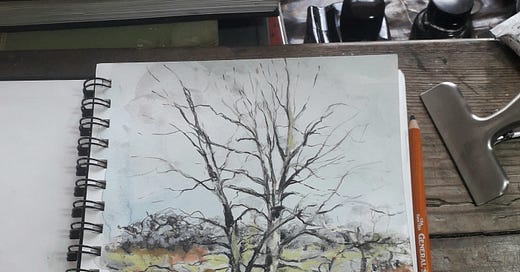



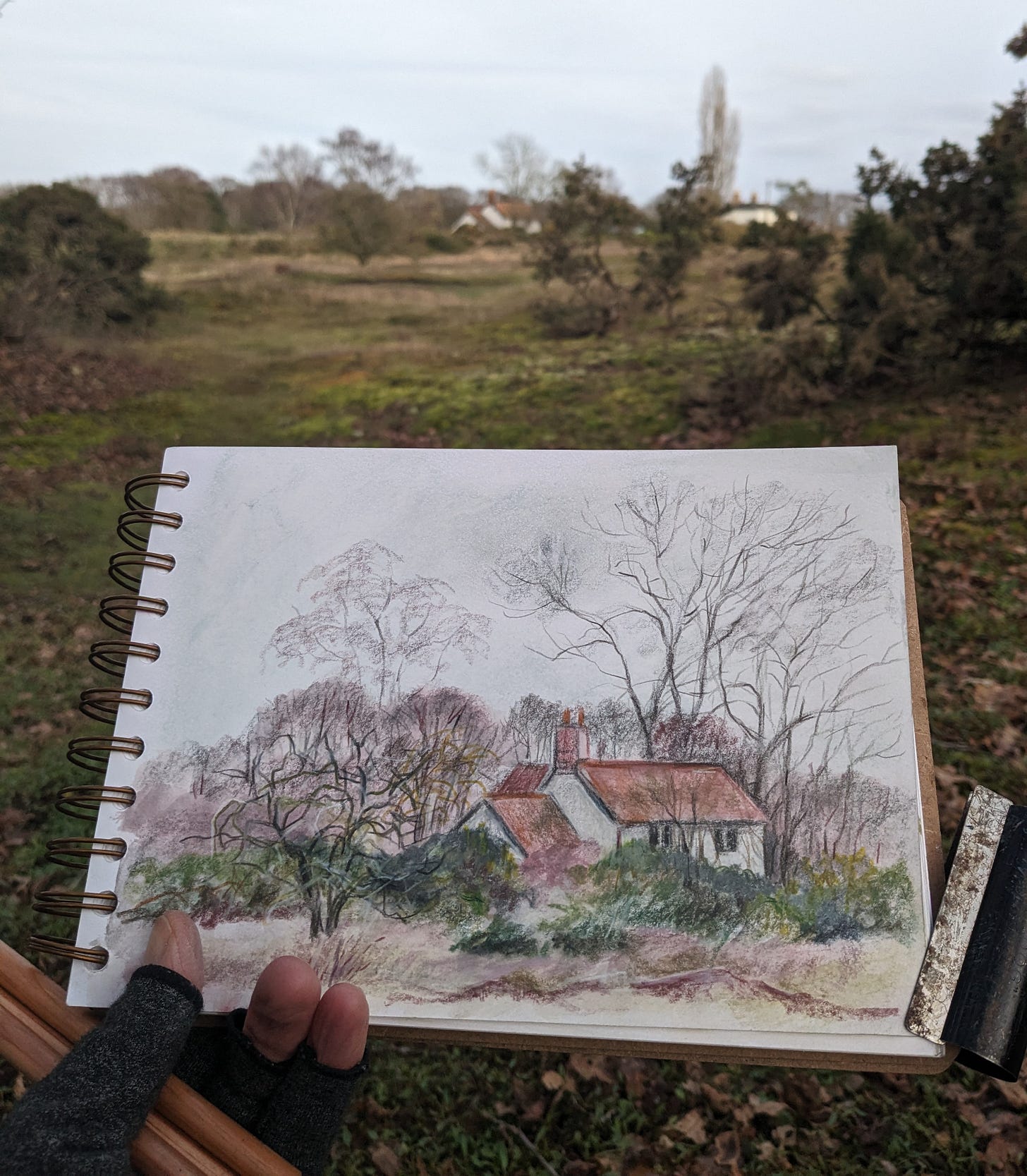
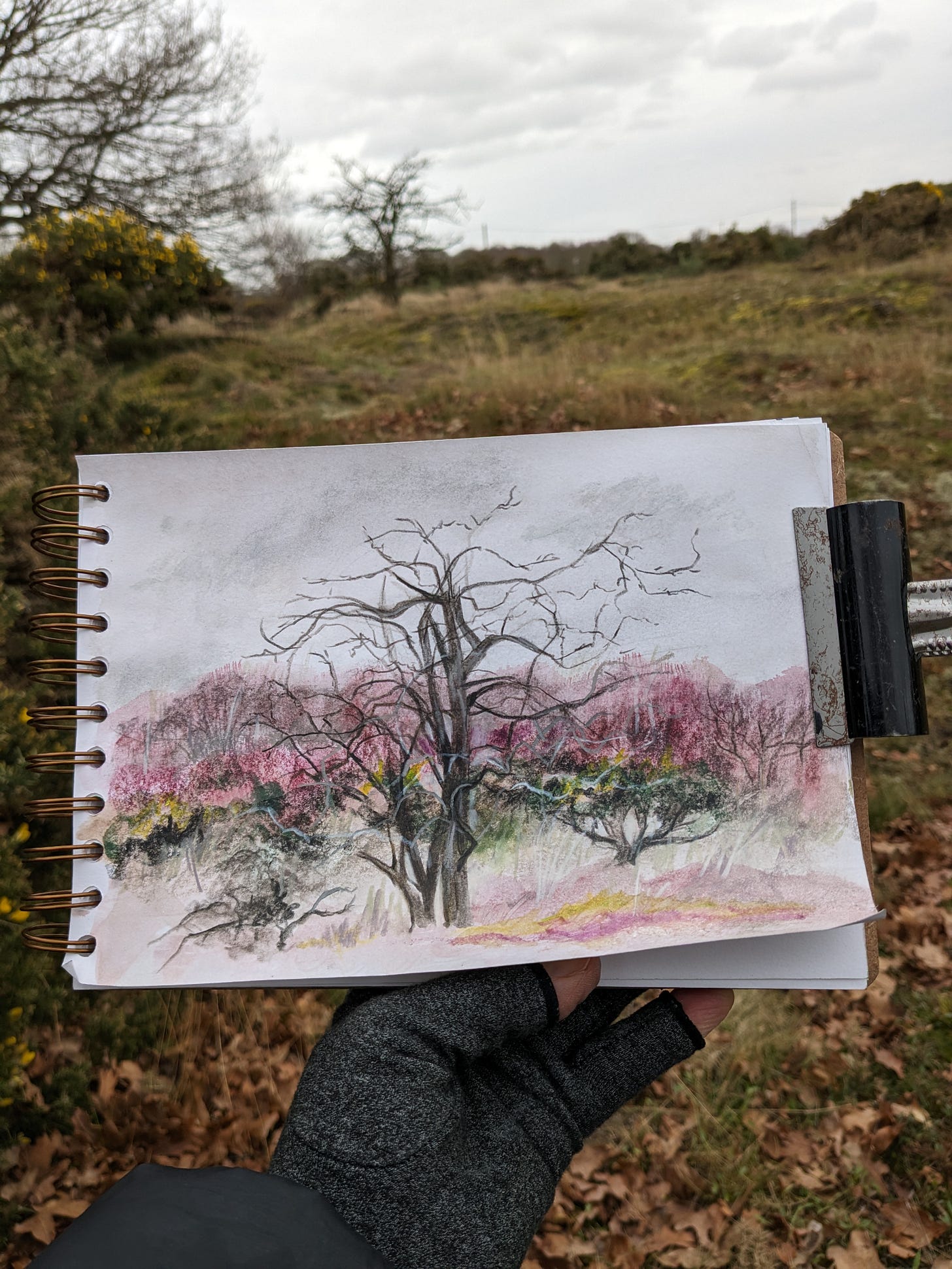
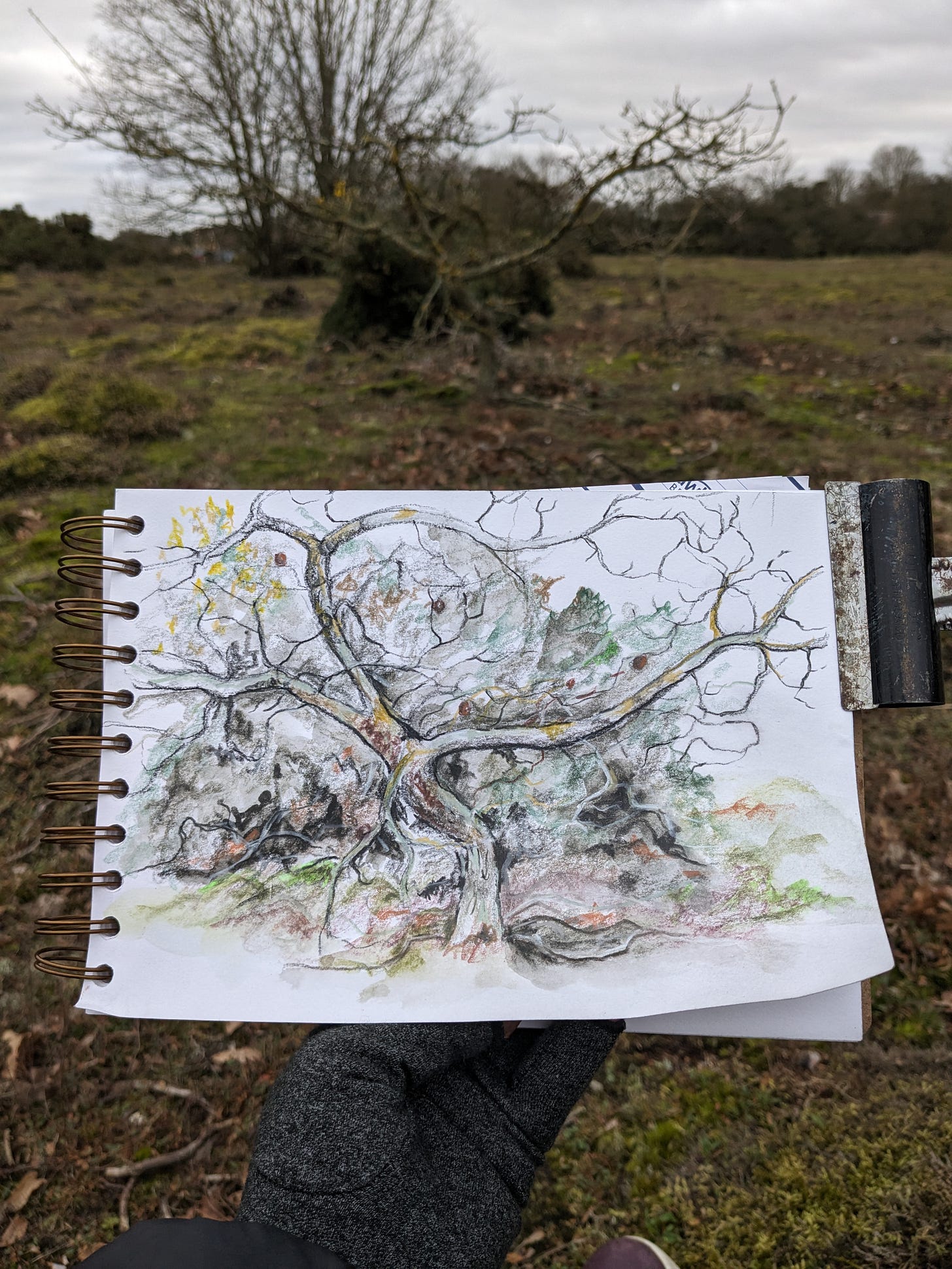
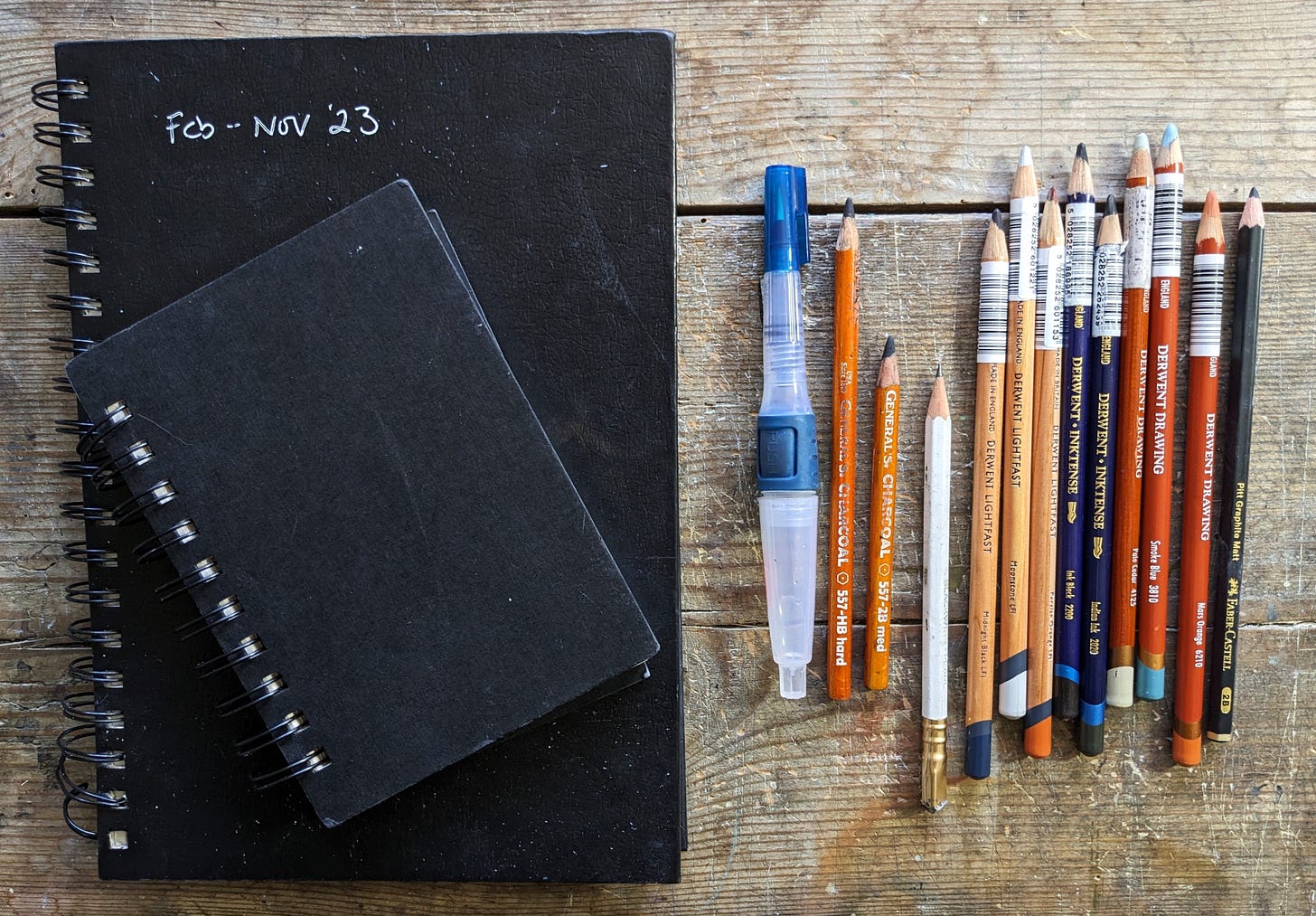
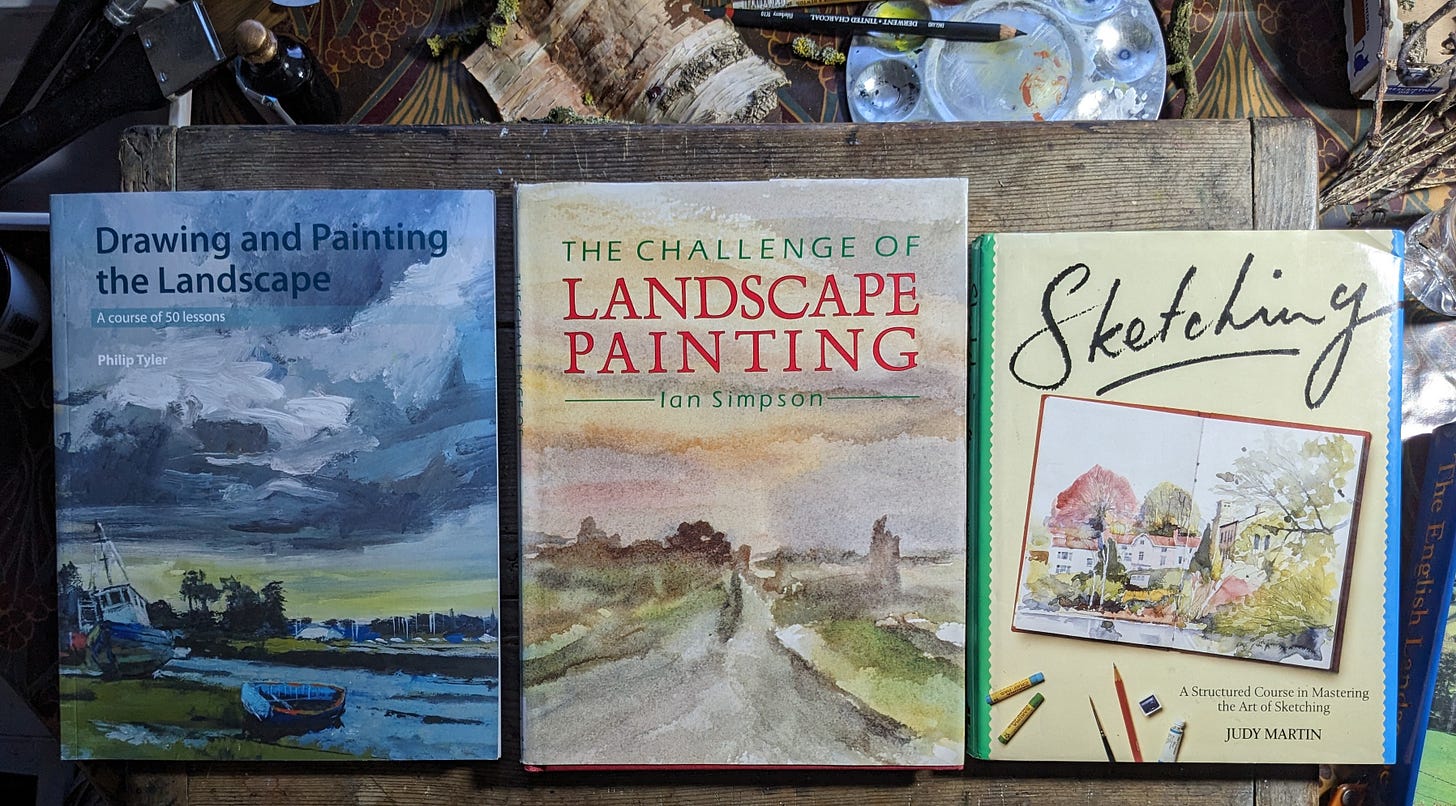
“Whatever your choice of creative pursuit, go to it, it is later than you think.” Wise words. Why do we feel guilty about it though? People often suggest it should be turned into a side hustle, as though it’s only worth doing if you can monetise it,which rather misses the point. Since finding your inspirational posts, I haven’t tried sketching outdoors (one day maybe) but I definitely look more closely as I walk.
I love your sketches, and this is such an inspirational read as always. I too I think was steered away from art in favour of science, because I could do both. I remember a cover-teacher setting us still-life drawing one lesson, and handing all our attempts in, one by one, at his desk on the way out - just in the corner of my eye I saw him pull mine out from the stack to look at properly, and I felt so uplifted - but in the end science won. I feel guilt at taking time to pursue anything creative because although I do sell a few pieces, I would earn more stacking shelves! But at the same time I know I have to create, so will hold Mary Oliver's words once again in my head. Thank you for sharing such practical, helpful details about what materials you use too, much appreciated.